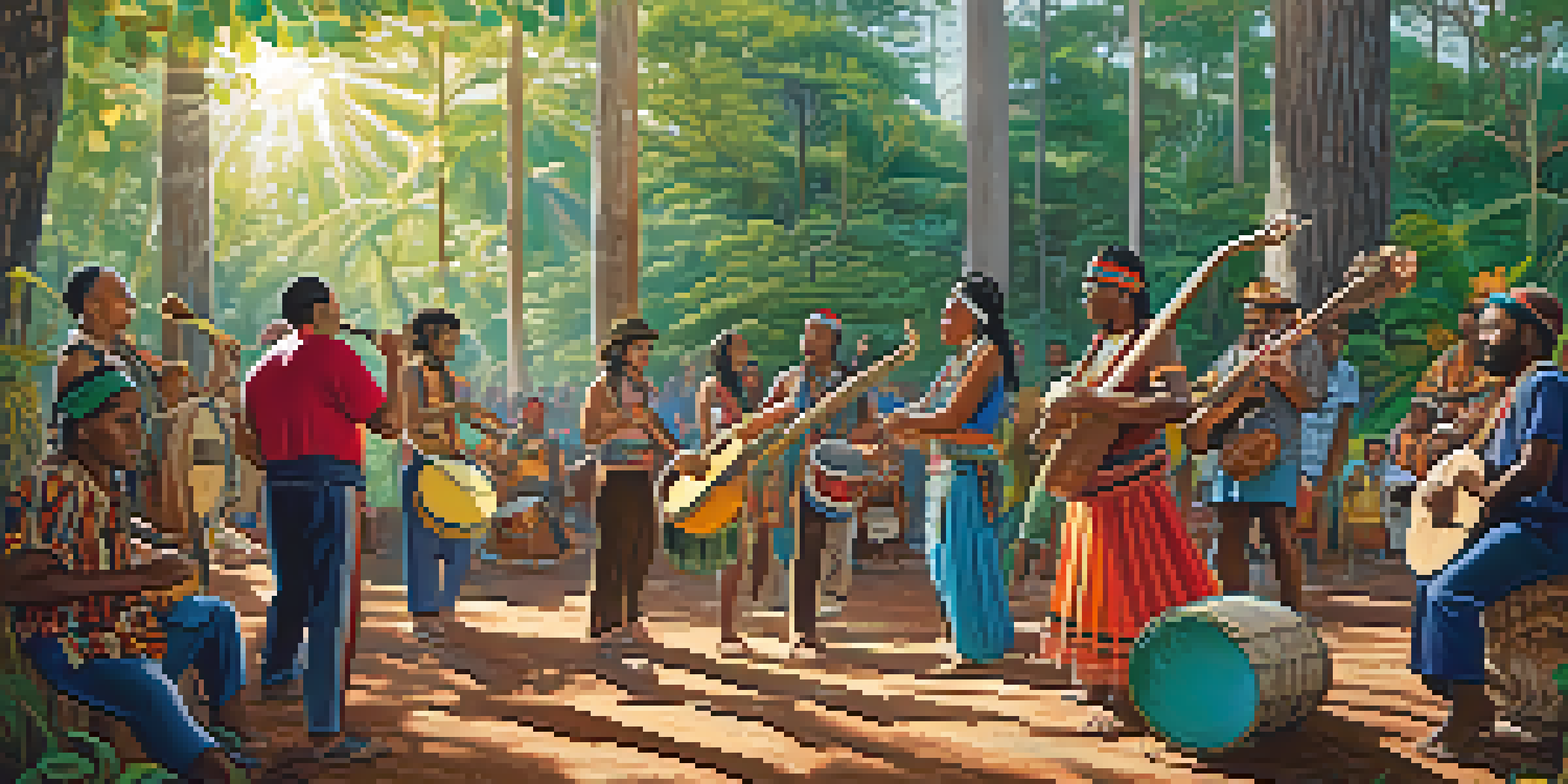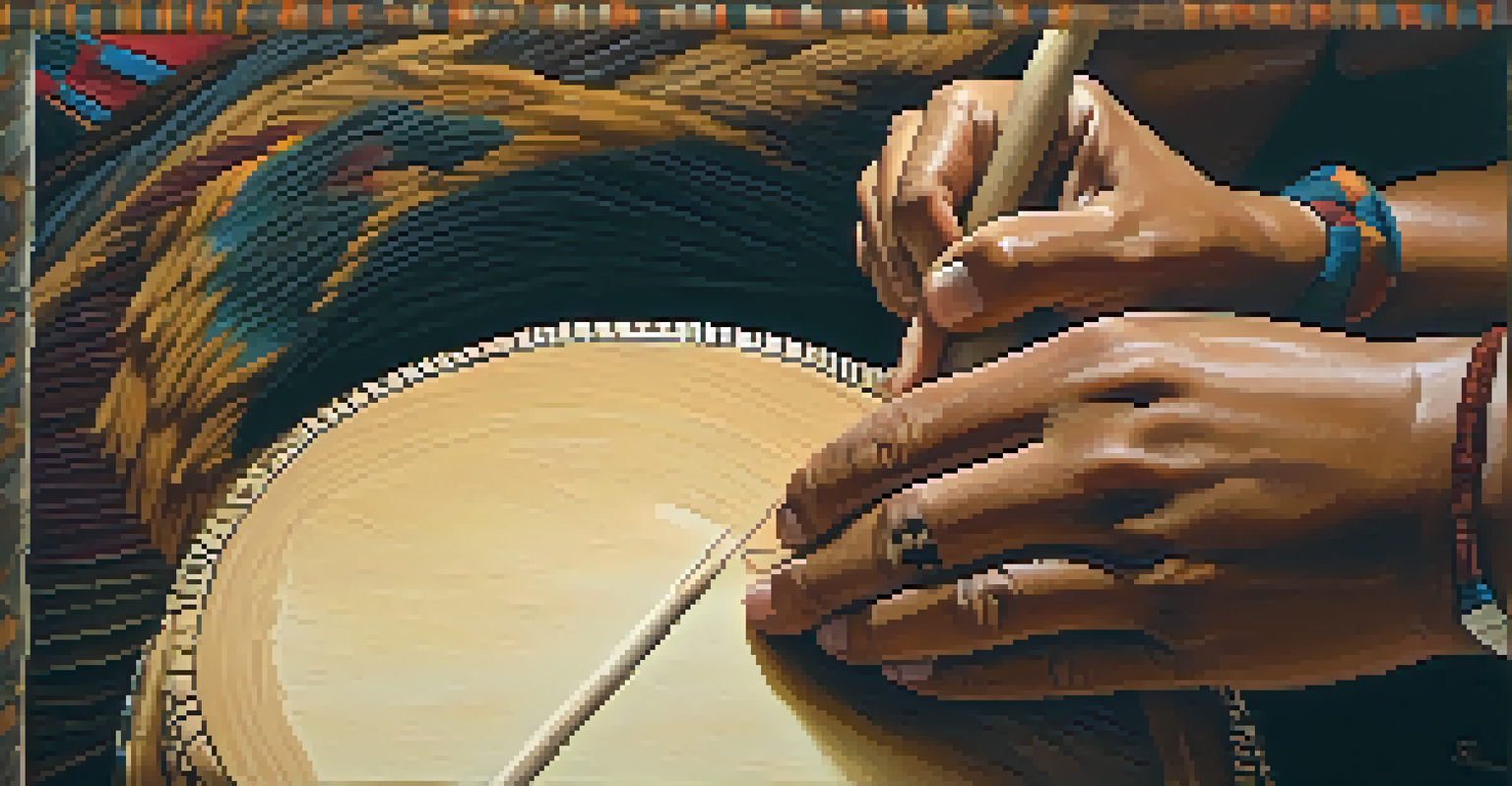The Impact of Colonialism on Indigenous Music Practices

Understanding Indigenous Music Before Colonial Influence
Indigenous music practices were deeply tied to cultural identity and spirituality before colonialism. These traditions often involved communal participation and were used in rituals, storytelling, and celebrations, reflecting the values and beliefs of the community. The diverse sounds and instruments varied significantly across regions, showcasing a rich tapestry of heritage.
Music is the universal language of mankind.
For instance, in North America, drumming and singing were integral to ceremonies, while in Australia, didgeridoos and clapsticks played a pivotal role in cultural expression. These practices were not just about music; they were a way of life, embedding teachings and history within their rhythms and melodies. The impact of colonialism would soon challenge these age-old traditions.
Understanding this foundational aspect of Indigenous music sets the stage for exploring how external forces reshaped these practices. The arrival of colonizers brought about significant changes, impacting not only the music but also the social structures that supported it. As we delve deeper, we will see how these shifts unfolded.
Colonial Disruption: The Initial Effects on Music Traditions
With the advent of colonial powers, Indigenous music faced an unprecedented disruption. Colonizers often viewed Indigenous practices as primitive or inferior, leading to efforts aimed at eradicating these traditions. This included the banning of cultural gatherings, which were essential for music-making, effectively silencing voices that had sung for generations.

As missionaries arrived, they introduced Western musical styles and instruments, imposing new forms of expression that contradicted Indigenous traditions. These changes often resulted in a significant loss of cultural heritage, as younger generations were encouraged to abandon their ancestral music in favor of European styles. This shift not only diminished musical diversity but also altered the cultural landscape drastically.
Resilience Amid Colonial Disruption
Indigenous communities have shown remarkable resilience in preserving their musical heritage despite the challenges posed by colonialism.
In many cases, Indigenous musicians began to incorporate Western elements into their music, reflecting a complex blend of influences. However, this adaptation came at a cost, as traditional practices were often overshadowed by the dominant colonial narrative. Understanding this disruption reveals the profound impact colonialism had on Indigenous music, setting the stage for resilience amidst adversity.
Cultural Resilience: Indigenous Responses to Colonialism
Despite the challenges posed by colonialism, Indigenous communities displayed remarkable resilience in preserving their musical heritage. Many groups sought to reclaim their traditions by revitalizing old songs and instruments, often incorporating contemporary elements to make them relevant for new generations. This blend of old and new not only honored their past but also reinforced their identity.
The preservation of our own culture does not require the destruction of another.
Community gatherings became focal points for revitalization efforts, where elders would teach younger members traditional songs and dances. These events were not just about music; they fostered a sense of belonging and continuity within the community. By embracing their musical heritage, Indigenous peoples found a way to resist colonial narratives and assert their cultural identity.
This resilience exemplifies the power of music as a tool for cultural survival. As Indigenous musicians began to weave their stories into contemporary contexts, they created a unique soundscape that honored tradition while embracing modernity. This journey of reclamation showcases the enduring spirit of Indigenous music practices, even in the face of colonial oppression.
The Role of Music in Indigenous Activism
Music has long served as a powerful medium for Indigenous activism, amplifying voices and messages in the struggle for rights and recognition. From protest songs to cultural anthems, Indigenous musicians have used their art to raise awareness about issues affecting their communities, including land rights, environmental concerns, and cultural preservation. These songs create a strong sense of unity and purpose among listeners.
For instance, during the American Indian Movement in the 1970s, music became a rallying cry for activists advocating for Indigenous sovereignty. Songs like 'We Are the Land' encapsulated the struggles faced by Indigenous peoples, resonating deeply within their communities. This use of music not only mobilized support but also fostered a renewed connection to cultural identity.
Music as a Tool for Activism
Indigenous musicians leverage music as a powerful medium for activism, raising awareness about social issues and cultural preservation.
As contemporary Indigenous artists continue to address social issues through their music, they remind us of the important role art plays in activism. By blending traditional elements with modern genres, they create a dynamic platform for storytelling and political commentary. This intersection of music and activism illustrates how Indigenous practices have evolved while remaining rooted in cultural significance.
The Influence of Globalization on Indigenous Music
In today's interconnected world, globalization has both positive and negative impacts on Indigenous music practices. On one hand, global platforms allow Indigenous artists to share their music with a wider audience, fostering appreciation and recognition of their cultural heritage. Collaborations with artists from different backgrounds can lead to innovative sounds that celebrate diversity.
On the other hand, globalization poses risks of cultural appropriation, where non-Indigenous artists may exploit Indigenous music without understanding its significance. This commodification can dilute the original meaning and context, leading to misrepresentation. As Indigenous musicians navigate this landscape, they must balance the benefits of exposure with the need to protect their cultural integrity.
Despite these challenges, many Indigenous artists are reclaiming their narratives by asserting ownership over their music. They are defining how their stories are shared, ensuring that their cultural significance is respected. This ongoing negotiation highlights the complexities of globalization and its impact on Indigenous music practices today.
Preservation Efforts: Reviving Indigenous Music Traditions
Efforts to preserve Indigenous music traditions have gained momentum in recent years, as communities recognize the importance of cultural heritage. Initiatives focused on archiving traditional songs, documenting oral histories, and teaching music to younger generations play a crucial role in keeping these practices alive. These programs foster appreciation and understanding of Indigenous cultures within broader society.
Organizations and cultural institutions have also stepped in to support these preservation efforts, providing resources and platforms for Indigenous musicians. Workshops, festivals, and educational programs create spaces where traditional music can flourish, encouraging collaboration and innovation. This revitalization not only reconnects communities with their heritage but also enhances cultural pride.
Globalization's Dual Impact
While globalization offers Indigenous artists wider exposure, it also raises concerns about cultural appropriation and the need to protect their heritage.
Through these preservation initiatives, Indigenous music practices are evolving while remaining deeply rooted in tradition. As new generations step up to share their stories through music, they contribute to a dynamic legacy that honors the past while looking forward. This commitment to preserving musical heritage ensures that Indigenous voices continue to resonate for years to come.
Conclusion: The Future of Indigenous Music Practices
The journey of Indigenous music practices is one of resilience, adaptation, and innovation in the face of colonialism. While colonial influences have undoubtedly shaped these traditions, Indigenous communities have demonstrated their strength by reclaiming and revitalizing their musical heritage. As we look to the future, it is essential to support and celebrate the diversity of Indigenous voices.
The evolution of Indigenous music will continue to reflect the dynamic interplay between tradition and modernity. As new artists emerge and engage with global influences, they will undoubtedly create unique sounds that honor their cultural roots while embracing contemporary themes. This ongoing dialogue will enrich the musical landscape and foster greater understanding across cultures.

Ultimately, the future of Indigenous music practices lies in the hands of those who are committed to preserving and sharing these traditions. By recognizing the importance of cultural heritage and supporting Indigenous musicians, we can ensure that their rich legacies endure, inspiring future generations to embrace their identities through music.